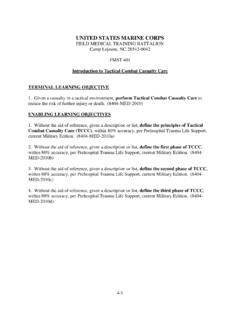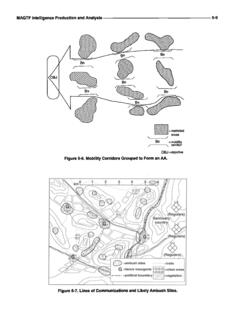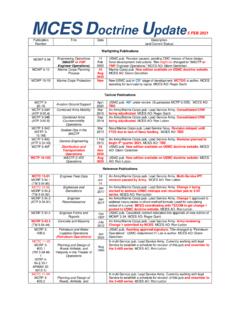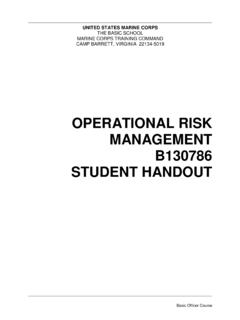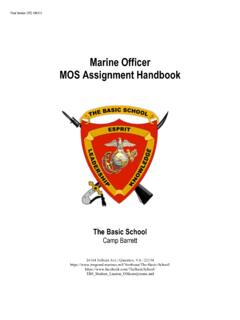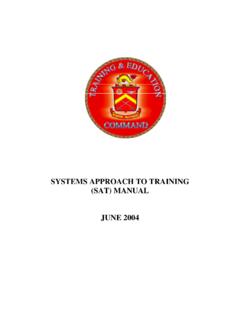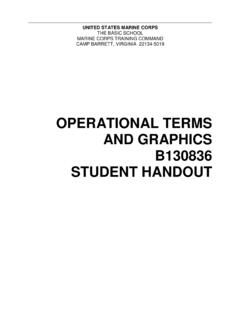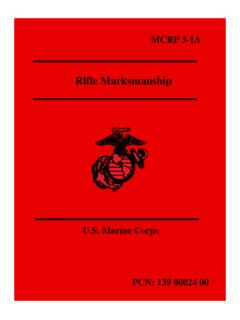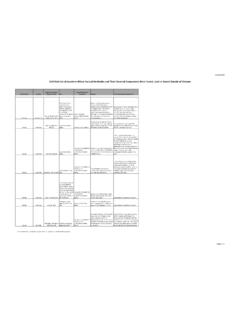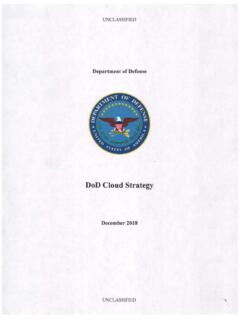Transcription of TACTICAL PLANNING B2B2367 STUDENT HANDOUT
1 UNITED STATES MARINE CORPS THE BASIC SCHOOL MARINE CORPS TRAINING COMMAND CAMP BARRETT, VIRGINIA 22134-5019 TACTICAL PLANNING B2B2367 STUDENT HANDOUT Basic Officer Course B2B2367 TACTICAL PLANNING 2 Basic Officer Course TACTICAL PLANNING Introduction and Importance Success in combat is reflective of a leader s ability to make tactically sound decisions in a time constrained and ever- changing environment. Success in this time compressed environment is based on the ability for our leaders to conduct detailed analysis (analytical decision making) of the complex information prior to entering that environment.
2 Only with the application of that analysis as a foundation, will the leader be able to apply the continuous analysis (recognitional decision making) necessary to make tactically sound decisions in the time compressed environment. As a leader, you must be familiar with the Troop-Leading Steps and the associated analysis that occurs to facilitate orders creation. The analysis is critical to overall mission accomplishment. It shapes the development of a tactically sound plan, communicated in the combat orders format, and shapes your decision- making process during mission execution. The process taught at The Basic School is lock-step only in sequence; the depth and detail by which the analysis is conducted is based on time and available information.
3 Leaders must understand the application of the analysis to the Marine Corps PLANNING in order to successfully modify the process without adversely affecting mission success. Prerequisites MCDP 1 Warfighting, introduced you to the nature of war which is inherently violent and chaotic, which we mitigate through clear communication of intent and simple plans. It discussed maneuver warfare, the theory of which is to strike the enemy s critical vulnerability (the decisive time and place) with massed fires to bend the enemy to our will. In the TACTICAL Fundamentals Discussion Group, you learned in depth the Nine Principles of War (MCDP 1-0) and the Six TACTICAL Tenets (MCDP 1-3); evaluative concepts that operate congruently to your TACTICAL PLANNING .
4 In Decision Making, you learned the importance of decisiveness in a time compressed environment. This was illustrated by the Boyd Cycle (OODA Loop) in which maneuver in time is achieved through an increased tempo of action. You also learned that as a leader and a Warfighter, you must be comfortable with making reasonable assumptions, supported by fact, to drive your operations. The ability to do this was defined by the 70% Solution. You learned the difference between analytical decision making and recognitional decision making. In this lesson we focus on analytical decision making. B2B2367 TACTICAL PLANNING 3 Basic Officer Course TACTICAL PLANNING (CONTINUED) In This Lesson We will discuss the six Troop-Leading Steps (BAMCIS), the TACTICAL PLANNING Process, and its relation to your mission PLANNING .
5 STUDENT Requirements This lesson covers the following topics: Topic Page Six Troop-Leading Steps (BAMCIS) 5 TACTICAL Thought Process 8 Begin PLANNING : METT-TC 12 Begin PLANNING : EMLCOA 18 Begin PLANNING : EXP 19 Begin PLANNING : SOM, FSP, Tasks 21 Arrange for Reconnaissance 22 Make Reconnaissance 22 Complete the Plan 22 Issue the Order 23 Supervise 23 Summary 23 References 24 Glossary of Terms and Acronyms 24 Notes 24 Appndx A: TACTICAL Thought Process & Order 25 Learning Objectives Terminal Learning Objective TBS-OFF-2102. Given a mission, implement Marine Corps Warfighting concepts, to accomplish the mission.
6 TBS-PAT-2002. Given a squad with attachments, a mission with commander's intent, paper, and pen, write a combat order, to support the achievement of higher headquarters intent. TBS-C2-1002. Given subordinate units, an order, and considering the situation and time available, issue a five paragraph order to communicate a complete, realistic, and tactically sound plan that accomplishes the mission. Enabling Learning Objectives TBS-OFF-2102k. Given a mission and commander's intent, develop a mental estimate of the situation using METT-TC to accomplish the mission. B2B2367 TACTICAL PLANNING 4 Basic Officer Course TBS-PAT-2002b.
7 Given a mission with a commander's intent, conduct an estimate of the situation, to accomplish the mission and meet the commander's intent. TBS-PAT-2002c. Given a unit, a mission with a commander's intent, and with supporting and attached units, determine Higher, Adjacent and Supporting mission (HAS), to accomplish the mission and meet the commander's intent. TBS-PAT-2002d. Given an order from higher headquarters, paper, and pen, develop commanders intent, to support achievement of higher's mission and includes each of the required items. TBS-PAT-2002e. Given an order from higher and a mental estimate of the situation, develop a scheme of maneuver to accomplish the mission.
8 TBS-PAT-2002g. Given an order from higher and a mental estimate of the situation, develop coordinating instructions, to accomplish the mission. TBS-PAT-2002j. Given an order from higher and a mental estimate of the situation, make reconnaissance, to confirm or deny assumptions to accomplish the mission. TBS-PAT-2002k. Without the aid of references, describe the troop leading steps without omission. TBS-C2-1002a. Given an order from higher, conduct TACTICAL PLANNING for an operations order IAW the METT-TC process. TBS-C2-1002c. Given an order from higher, conduct map reconnaissance IAW the troop leading steps.
9 B2B2367 TACTICAL PLANNING 5 Basic Officer Course Six Troop Leading Steps (BAMCIS) In layman s terms, PLANNING is easy to conceptualize. In the civilian world when given a task to do by your boss, provided the time was available, you would in general terms: 1. Determine what needs to get done to complete the task and what information you need to complete the task. During this time you may develop questions, pertaining to completing the task, for which you do not have the answer. To continue PLANNING how to complete your task, some of those questions will be deliberately answered by assumptions you make.
10 For others that do not impede your PLANNING , you will seek to answer later when you gain more information. You will emerge with an initial plan to complete the task. 2. To validate your initial plan, you would identify where to find additional information that will aid in you completing your task. You may identify the internet, library, or subject matter experts as sources of information that will either answer the questions you still have after your initial plan, and/or prove your assumptions made during your PLANNING . You would then build a research plan to execute. 3. To execute your research, you would focus on the source of information that would provide you the most effective answers to your questions.
